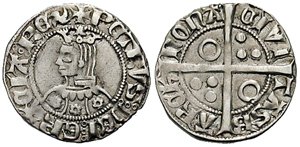Contents / Continguts
Medieval coins of Catalonia
Here is one of the most sought-after Catalan coins: the medieval Croats. The medieval croats and the banknotes issued by the Generalitat de Catalunya —the Government of Catalonia— during the Civil War —although the latter, to be more accurate, would fall into the world of note collecting known as notaphily— are the Holy Grail of Catalan numismatics. Yes, there is a great deal of interest in these pieces, and in recent years they have gone up in price at both auctions and numismatics.
History
The Quatern was a Catalan vellon coin created by Peter II in 1212. It was also known as Court coin. Its value was four silver marks and eight copper marks.
In 1346 Peter III the Ceremonious created a new coin: the gold Florin of Aragon , and established a mint in Perpignan for the minting of royal gold coins . It was minted imitating of those of Florence. In addition to Perpignan, it was also minted in Barcelona, Gerona, Valencia and Majorca, but never in Aragon.
The Croat was a Barcelona silver coin, minted from the time of Peter II (1177 – 1213) until Philip V (1683-1746). It was also called Barcelonese silver money, real silver money and thick white coin. Its name comes from the cross on the back. It was abolished in 1718 with the New Royal Decree .
The Counts of Barcelona gradually extended their dominion and currency throughout Catalonia.
The seca (mint) in Barcelona minted coins called Diners and Obols, which had less and less silver content.
It was in the time of James I, the Conqueror, that the stability of the numerarie was achieved. The numeraire is liquid or cash money, i.e. coins, banknotes and short-term current accounts. The numeraire also usually refers to the amount of circulating money (mainly coins and banknotes) that exists in a country at any given time.
The first attempt to make a strong silver coin struck in Barcelona dates back to 1268, but it could not be made due to the opposition of the nobles of Barcelona.
The famous Barcelona coin, called the Croat, was first struck in the first week of August 1285, and it was Peter II, the Great, son of James I, the Conqueror, who ordered it to be issued.
The birth of the Catalan Croat is associated with the period of expansion of the Catalan-Aragonese Crown.
The obverse shows the bust of the king who decided to strike the coins, always looking to the left and with a crown on his head. The reverse of the coin shows the long-armed cross, which is the origin of the old name ‘crucesigneds’ and later the Croat.
The weight of the croat was 3.23 grams of silver.

How many grams are an ounce?
To put this in context, one ounce equals 28.35 grams.
Peter II the Great (1276-1285)
The first legal issues of croats began in the first week of August 1285, a few months before the death of Peter II the Great (who reigned from 1276 to 1285 and was the son of James I the Conqueror and Violant of Hungary). Very few examples of croats from this reign are known and therefore are extremely rare.

Price
It is a rare croat, and the starting price at auction is 750€, easily reaching 3000€.
It must be said that there are croats that are much more affordable than those of Peter II. For example, a croat of James II (1291-1327) has a starting price of around €80 and is sold for €216 in VF, VF20 or VF25 (according tothe sheldon coin grading scale). A croat of Peter III can be obtained for little more than €80.
For those of you who are already familiar with coin collecting, you already know that the condition of the coin has a direct impact on its price. However, sometimes there are coins that are so unique that their condition takes a back seat.

